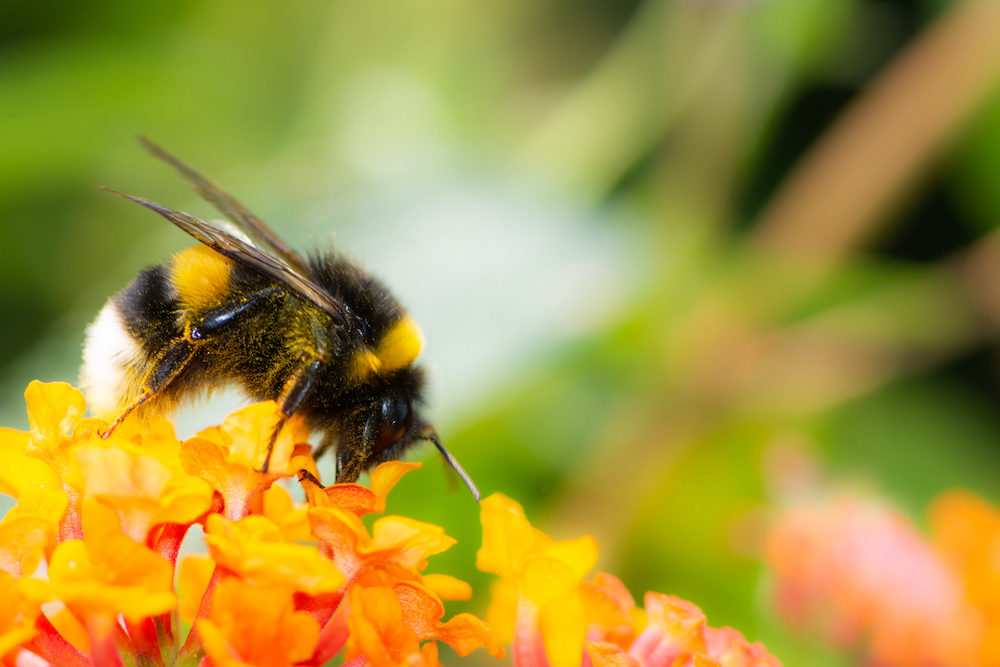5 Common Questions About Bumble Bees

When it comes to bees, there’s nothing cuter than a bumble bee. Their pudgy, furry little bodies buzz from flower to flower. For many people, the sound brings back memories of the warm summers of their childhoods. Bumble bees have some unique properties that set them apart from honey bees, even though both are vital pollinators who help to sustain our ecosystem.
Let’s learn a bit more about bumble bees and their role in the environment. In this article, we will share 5 common questions that we frequently get about bumble bees so you can better appreciate this fascinating creature.
Where do bumble bees live?
In comparison to honey bee hives, bumble bees build relatively small nests. A typical bumble bee nest may contain up to 400 bees, so they only require a relatively small space.
An impregnated queen will begin the search for a nest in the spring, after she emerges from her winter hibernation. She will perform a distinctive zig-zag flight, staying low to the ground, in search of the perfect location.
Some bumble bees will build a nest underground in a rodent hole or under a structure such as a shed or garage. Others will build a nest above ground in thick grass, in trees or even in bird boxes.
Overall, bumble bees prefer shaded locations that are separate from any disturbances. This information will be important for question 4!
Can bumble bees sting you?
It is true that you can be stung by a bumble bee. However, bumble bees are generally very docile. They will not become aggressive unless they are directly agitated. Female bumble bees have stingers and may sting you if they are provoked. Male bumble bees are unable to sting.
Unlike honey bees who have barbed stingers, bumble bees have smooth stingers. This is important because a smooth stinger will not get stuck in a victim and result in the death of the bumble bee, like it does for the honey bee. So while a female honey bee is only able to sting once, technically a bumble bee could sting multiple times without dying.
Do bumble bees make honey?
Unlike their honey bee cousins, bumble bees do not make honey. Honey bees need honey in order to sustain the colony throughout the winter. Bumble bees, on the other hand, do not need to store food for the winter.
The new queen bumble bee is the only bee that survives at the end of the season. She will hibernate for the winter, while the other bees, including the males, female workers and the old queen, will not survive.
Why does this bumble bee keep bumping into my window?
Another common activity you may see bumble bees engage in is bumping into windows! Frequently, new queen bumble bees get a little confused when searching for a new nest location.
Since they prefer to build their nests in cooler locations, they are naturally attracted to shady areas. The glass windows of your home or vehicle can often appear to be shaded, and understandably enticing to the queen. After all, she has just woken up from a very long nap and is desperately searching for a place to start her family!
Why is this bumble bee digging in the ground?
Sometimes, you may see a bumble bee digging a hole in the ground and wonder what they are up to. As we mentioned earlier, some bumble bees will build their nests underground. Depending on the time of year, a fertilized queen could also be starting to hibernate for the winter.
Another possibility is that the bumble bee has been infected by a parasite. Certain parasites can change the behavior of a bumble bee or even attack them during hibernation.
Like their honey bee cousins, bumble bees are interesting insects to study. Similarly to honey bees, bumble bees play a role in pollination and sting when they are provoked. Unlike honey bees, they do not produce honey and generally live in smaller groups of less than 400 bees. Even their life cycles are different – but that’s for another article!
Check the D-Tek Live Bee Removal Bee Blog again soon for more fascinating facts about the bumble bee.
